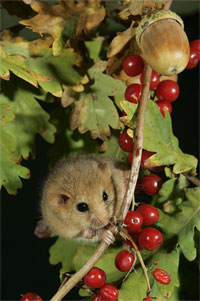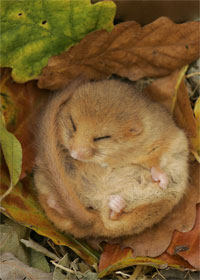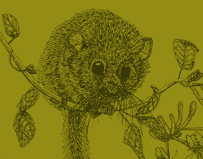
The Hazel Dormouse Muscardinus avellanarius is native to the UK. It is a rare species, a small mammal with a sandy coloured coat, white chest patch, furry tail and large black eyes. They spend most of their time up in trees where they use their prehensile feet to grip on to the branches. Dormice are able to rotate their feet like squirrels, enabling them to run down trees.
During the Spring, Summer and Autumn dormice make a ball shaped nest out of stripped honeysuckle bark and leaves, they use dormouse boxes extremely readily, but their natural nest sites are in thick hedges or in holes in trees. Natural nest sites may be a limiting factor for dormice populations and this is why nestboxes are so helpful to them.
Dormice are not readily seen as they are quite rare, spending most of their time up trees, they are also nocturnal. Added to this they hibernate underground in Winter, so if you go out looking for dormice it is extremely hard to see them!
Note:
There is another dormouse species in the UK, which is the Fat or Edible Dormouse Glis glis, which is a non-native species. The Fat Dormouse, found in Hertfordshire, is much larger than the Hazel Dormouse and grey in colour. They have different habits to Hazel Dormice and these webpages do not necessarily apply to them.
photos by Danny Green
Dormice hibernate throughout the winter. The amount of time spent in hibernation varies depending on the weather and also the individual dormouse.
The larger and generally older animals will hibernate earlier as it is not as difficult for them to gain the body weight required for them to survive the winter conditions. The younger animals however, especially if they were born late in the season, have a difficult task of gaining enough fat reserves for the winter and are therefore the last ones to hibernate.
Hibernation also depends on the weather conditions, the warmer the winter, the later the dormice hibernate. The dormice prefer short cold winters, this is because, when hibernating, their body temperature is only a few degrees above zero and their heart only beats a couple of times a minute. However they cannot lower their temperature below that of their surroundings. When it is mild the body temperature is higher, therefore they cannot slow down their metabolism as much. This results in them using up more of their fat reserves and waking up earlier.
In recent years the UK has been experiencing warmer winters leading to dormice waking up earlier. However in many years there has been a cold spell once the dormice are out of hibernation and this can proof lethal. Hibernation usually starts in October/December and continues until February/March.
During cooler periods of the summer months the dormouse goes into a semi-hibernation state called torpor, when the dormouse lowers its metabolism to save their fat reserves. It appears that pregnant females will not go into a torpid state, perhaps because they need to stay warm in order to nourish the developing young.



